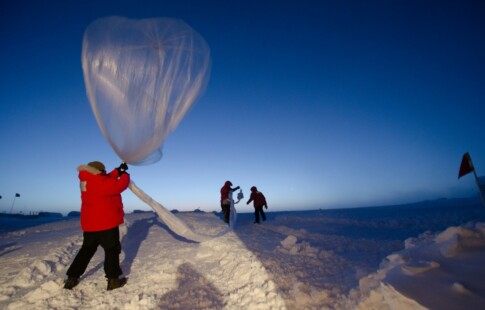
Do Scientists Know What Causes Solar Storms?
We are reader-supported. When you buy through links on our site, we may earn affiliate commission.
Most of us only think of the sun in passing. On hot afternoons when we hide beneath the shade, or rainy mornings when we wish for a little light, the sun is a subject of discussion. Otherwise, it’s all too easy to forget that our planet survives on the heat from a fiery ball of hot plasma 1.3 million times its size.
With this enormous number in mind, the concept of a “solar storm” is somewhat frightening. After all, the scale of our sun is immense and its power is incredible. It seems probable we’d eventually have to reconcile the fact that we live a very short distance from it, by astronomical standards.
In truth, solar storms aren’t as dangerous as they sound. They’re part of a cycle of high and low activity that repeats every 11 years. This cycle’s “solar maximum,” or peak, occurred between 2013 and 2014. As NASA predicted, we didn’t see any catastrophic solar events like some feared.
So what exactly are “solar storms” and how do they affect the Earth? Do scientists know what causes them? If so, what are the reasons behind this fascinating phenomenon? We’ll answer those questions and others like them by taking a comprehensive look at the many intriguing aspects of solar storms.
The Science of Solar Storms
Magnetic storms on the surface of the sun can cause flares. These explosions have the capacity to release as much as one-sixth of the sun’s entire output in a single second. When the storms are exceptionally strong, they erupt in coronal mass ejections — or CMEs — which are essentially huge clouds of plasma.
These clouds of plasma consist of energetic protons and electrons, with smaller amounts of iron, helium and oxygen, all traveling at millions of miles per hour. So what happens when this fast-traveling cloud of electrons, protons, iron, helium and oxygen reaches our planet? What do we see from the ground?
First, the burst of radiation ionizes the outer atmosphere, affecting global positioning satellites and other equipment. The energetic protons make contact around 10 to 20 minutes after the initial flare. Another 10 to 30 hours after that, the CME hits and causes electrical currents to surge along oil pipelines and high-tension electricity lines, resulting in blackouts in some areas and a beautiful light show in others, similar to the aurora borealis.
Of course, the most we usually see from high-energy radiation are the aurora borealis and the aurora australis. While a large-scale disruption from a solar storm is possible — and potentially costly — it isn’t as pressing as other issues facing the world today. In other words, solar storms aren’t a top concern, regardless of the sun’s scale and power.
The Cause of Solar Storms
Though we understand the composition of solar storms, the reason behind the phenomenon is slightly more complicated than, “huge clouds of plasma.” NASA researchers have studied the cause of these CMEs and have come to the conclusion that the magnetic field lines of the sun contribute to these events.
On the subject of CMEs, NASA states: “They explode into space at a very high speed when the sun’s magnetic field lines suddenly organize.” Even with this knowledge, we have no way of preventing solar storms at the moment, although engineers have strategies in place to adjust for them.
So what happens when an incoming “solar maximum” receives too much public attention?
The Solar Storm of 2013
As mentioned earlier, the sun’s cycle of high and low activity reached its peak between 2013 and 2014. During the “solar maximum,” thanks to activity on the sun and the possibility of space weather, the effects on our environment are greater than usual. Despite reassurance from NASA scientists, some people planned for the worst.
Since the planet’s dependence on electronic technology had increased since the previous peak in activity — which occurred in 2002 — certain groups believed the world was more vulnerable to the effects of solar storms. Beyond your average skeptics, several proponents of this idea were in high positions of power.
The chief scientific advisers to former President Barack Obama and the government of the U.K. said in a joint statement, “Space weather can affect human safety and economies anywhere on our vast planet, and blasts of electrically-charged gas traveling from the sun at up to five million miles an hour can strike with little warning.”
These advisers predicted the impact could cost $2 trillion in the first year for the United States alone, with recovery efforts spanning a period of four to 10 years. Of course, none of this came to pass — but it’s important to recognize that these types of events often result in some form of hysteria, and it’s rarely warranted.
Moving Toward the Future
NASA is prepared for potential problems from solar storms. They maintain a fleet of Heliophysics spacecraft to monitor the space environment between the sun and Earth, facilitating progress with the data they collect. In coordination with other agencies, they’ve ensured the safety of U.S. citizens.
At the same time, solar storms aren’t likely to spell the end of our planet. Although they’ve caused problems in the past, our future is secure.
Share on
Like what you read? Join other Environment.co readers!
Get the latest updates on our planet by subscribing to the Environment.co newsletter!
About the author
Jane Marsh
Starting from an early age, Jane Marsh loved all animals and became a budding environmentalist. Now, Jane works as the Editor-in-Chief of Environment.co where she covers topics related to climate policy, renewable energy, the food industry, and more.





